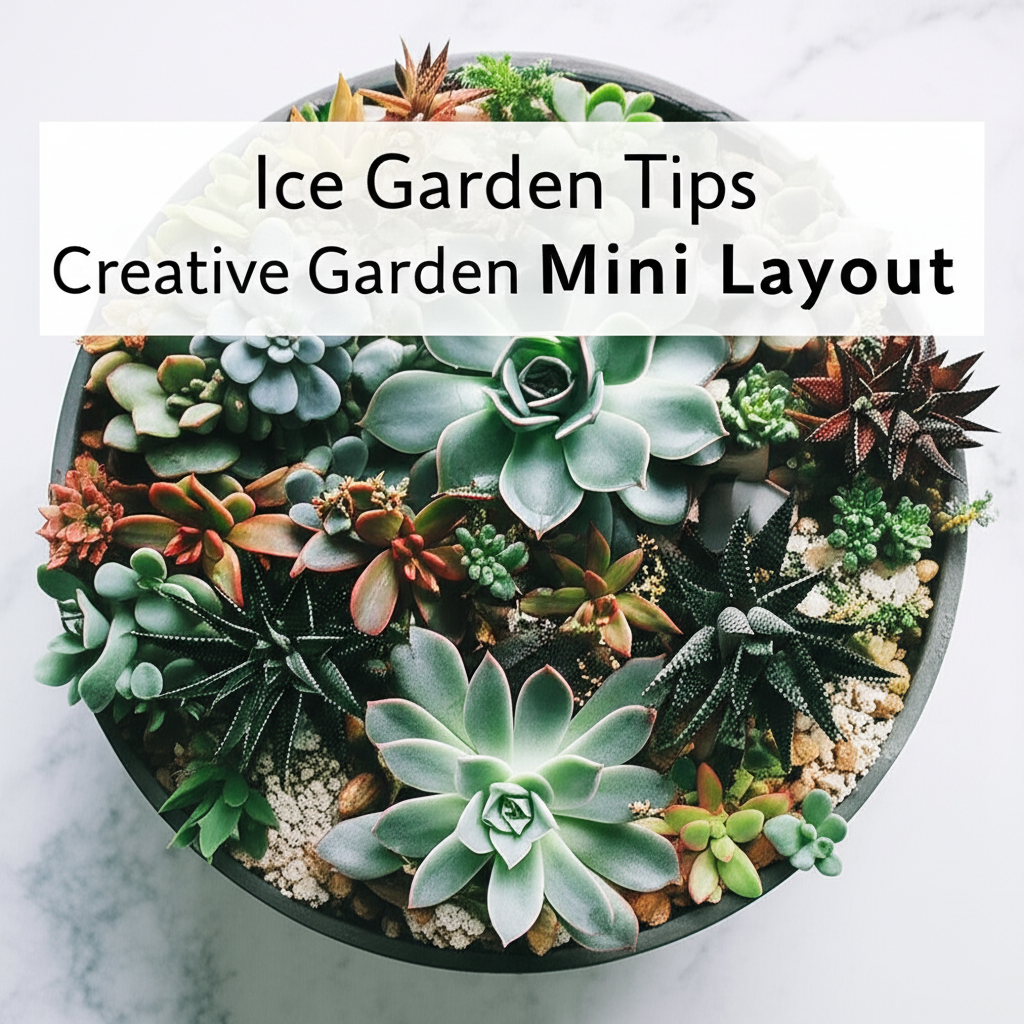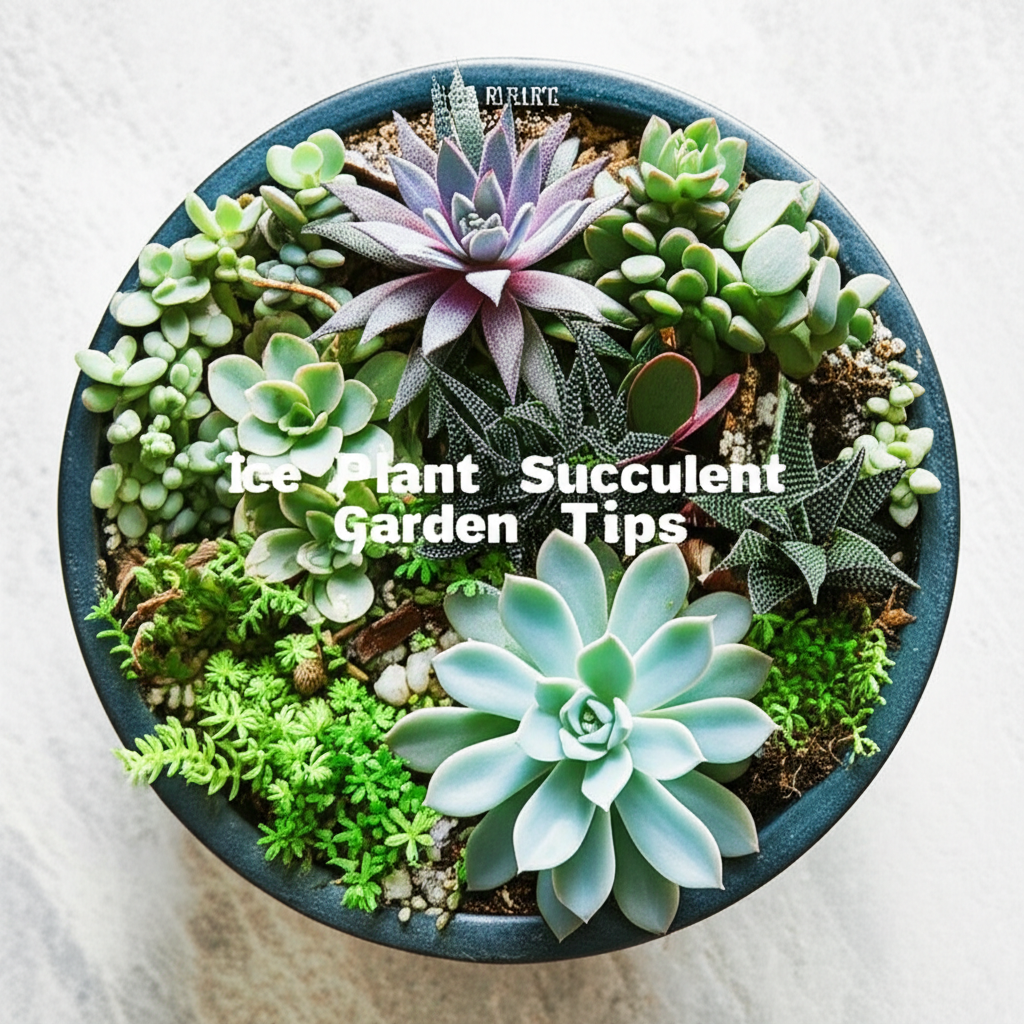The Allure of the Ice Plant: More Than Just a Pretty Face
Ice plants, scientifically known as members of the Aizoaceae family, are a diverse group of succulents renowned for their unique crystalline epidermal cells. These specialized cells, often referred to as “blisters” or “papillae,” scatter sunlight, creating a shimmering, icy effect that gives the plants their captivating name. Beyond their aesthetic appeal, many ice plants are remarkably resilient and adaptable, making them ideal candidates for indoor gardening, particularly for creating charming and low-maintenance tabletop displays. Their compact growth habits and drought tolerance align perfectly with the demands of limited space and busy lifestyles. This guide delves into the creative possibilities of cultivating ice plant succulents for unique and eye-catching indoor tabletop garden mini layouts.
Understanding Your Ice Plant Varieties
The term “ice plant” encompasses a wide array of species, each with its own distinct characteristics. For tabletop gardening, focusing on smaller, slower-growing varieties is key. Some popular and suitable choices include:
- Delosperma species (e.g., ‘Cooperi’, ‘nubigenum’): Known for their bright, daisy-like flowers and creeping habit, making them excellent for trailing over the edges of containers.
- Lithops species (Living Stones): These fascinating plants mimic pebbles and stones, offering an almost surreal appearance. They require very specific care, particularly regarding watering.
- Fenestraria rhopalophylla (Baby Toes): Distinguished by its finger-like leaves with translucent tips, resembling tiny toes.
- Conophytum species: Tiny, clustered succulents that often form dense mats of rounded leaves. Many are dormant in summer and grow in winter.
- Pleiospilos nelii (Split Rock): Another stone mimic, featuring thick, segmented leaves that resemble weathered rocks.
Key Facts for Tabletop Ice Plant Gardens
| Attribute | Description |
|---|---|
| Light Requirements | Bright, indirect sunlight is ideal. Direct, intense sun can scorch some varieties. Aim for at least 6 hours of light per day. |
| Watering | Drought-tolerant. Water thoroughly only when the soil is completely dry. Overwatering is the most common cause of death. |
| Soil | Well-draining succulent or cactus mix. A gritty, sandy composition is crucial. |
| Temperature | Prefers average room temperatures (65-80°F / 18-27°C). Avoid extreme fluctuations and cold drafts. |
| Humidity | Low humidity is preferred. Good air circulation is important. |
| Container Type | Porous materials like terracotta are best to allow for good drainage and air circulation. |
| Fertilizer | Rarely needed. If fertilizing, use a diluted succulent fertilizer during the growing season (spring/summer). |
Designing Your Mini Ice Plant Layout: Creative Concepts

The beauty of a tabletop garden lies in its intimacy and ability to transform a small space into a captivating miniature landscape. Ice plants, with their diverse forms and textures, are perfect for this.
Theme-Based Tabletop Gardens
Consider a theme to guide your plant selection and arrangement. This adds a narrative element to your garden.
- Desert Oasis: Combine various ‘Lithops’ and ‘Pleiospilos’ to mimic a rocky desert floor. Add small decorative stones and sand for a realistic touch.
- Zen Garden: Use a shallow, wide container and arrange a few ‘Conophytum’ clusters with raked gravel and perhaps a tiny decorative element like a miniature Buddha.
- Fairy Garden: Incorporate trailing ‘Delosperma’ around the edges, interspersed with tiny ‘Fenestraria’ and whimsical miniature accessories.
- Geological Display: Group ice plants with interesting rock formations, showcasing the natural camouflage of species like ‘Lithops’ and ‘Pleiospilos’.
Container Choices for Impact
The container is as important as the plants themselves. Think about material, shape, and size.
- Shallow ceramic or terracotta bowls: Ideal for showcasing a variety of small succulents and their root systems.
- Wooden shallow trays or planters: Offer a natural, rustic feel that complements the earthy tones of many ice plants.
- Glass terrariums (open top): While glass can trap humidity, open-top terrariums can work if drainage is impeccable and ventilation is excellent. They offer a clear view of the root system and substrate.
- Repurposed items: Old teacups, shallow ceramic dishes, or even small, rustic wooden boxes can be transformed into unique planters. Ensure adequate drainage is added if none exists.
Arrangement Techniques for Visual Appeal
Balance, texture, and color are key to creating a visually pleasing arrangement.
- Height Variation: Use plants of different heights to create depth and interest. Taller, upright succulents can be placed towards the back or center, while low-growing or trailing varieties can spill over the edges.
- Texture Contrast: Mix plants with different leaf textures – smooth, bumpy, or crystalline – to add tactile and visual richness.
- Color Harmony: While many ice plants are green or gray-green, some develop reddish or purplish hues when exposed to more light. Consider how these colors will interact.
- Negative Space: Don’t overcrowd the container. Allowing some empty space, often filled with decorative gravel or sand, helps each plant stand out and prevents a cluttered look.
- Focal Point: Designate one or two plants as the focal point, perhaps a particularly interesting ‘Lithops’ or a specimen with vibrant flowering.
Essential Care for Thriving Tabletop Ice Plants
Even the most beautiful design will falter without proper care. Ice plants have specific needs that, once understood, are quite straightforward to meet.
The Art of Watering: Less is More
Overwatering is the cardinal sin when it comes to succulents, and ice plants are no exception.
| Watering Strategy | Details |
|---|---|
| Frequency | Water only when the soil is completely dry to the touch, usually every 2-4 weeks, depending on environmental conditions. |
| Method | Water thoroughly until water drains from the bottom of the pot. Avoid misting, which can lead to fungal issues. |
| Seasonal Adjustments | Reduce watering significantly during cooler months when plants are often dormant or growing more slowly. |
| Observation | Look for signs of thirst: slightly shriveled or softened leaves. Conversely, mushy or yellowing leaves indicate overwatering. |
Light and Location: Finding the Sweet Spot
Your tabletop garden needs a prime location.
- Bright, Indirect Light: A south-facing window that receives bright light but is shielded from the harshest midday sun is often ideal. East or west-facing windows can also work.
- Monitor for Sunburn: If your plants develop brown or bleached patches, they may be getting too much direct sun. Move them to a spot with slightly less intense light.
- Rotate for Even Growth: Periodically rotate your containers to ensure all sides of the plants receive adequate light, promoting even growth.
Soil and Drainage: The Foundation of Health
The right soil mix is critical for preventing root rot.
- Commercial Succulent/Cactus Mix: Start with a good quality commercial mix.
- DIY Blend: For enhanced drainage, amend a standard potting mix with perlite, pumice, or coarse sand (about a 50/50 ratio).
- Grit is Key: Ensure the mix is gritty and airy. Avoid heavy, moisture-retentive soils.
Temperature and Airflow: Creating a Conducive Environment
Ice plants are generally tolerant of typical indoor temperatures but benefit from good airflow.
- Stable Temperatures: Aim for temperatures between 65-80°F (18-27°C) during the day and slightly cooler at night.
- Avoid Drafts: Keep plants away from direct drafts from air conditioners or heating vents, as sudden temperature changes can be stressful.
- Good Ventilation: Ensure the room has good air circulation. This helps prevent fungal diseases and keeps the air dry, which is ideal for succulents.
Creative Enhancements and Maintenance Tips
Once your basic layout is established, you can elevate it with thoughtful additions and regular upkeep.
Incorporating Decorative Elements
Small additions can have a big impact.
- Miniature Figurines: Tiny animals, garden gnomes, or even abstract sculptures can add personality.
- Decorative Stones and Pebbles: Use a variety of colors and textures to mimic natural landscapes or create patterns. Small river rocks, polished stones, or even colorful gravel can be used.
- Sand Art: Layering different colored sands can create a striking visual effect, especially in clear containers.
- Mosses (Dried): Preserved mosses can add a touch of green and texture without requiring moisture.
- Driftwood or Small Branches: These can add a natural, weathered look and provide a sense of scale.
Propagation for Expansion
Many ice plants are easy to propagate, allowing you to expand your collection or replace aging plants.
- Stem Cuttings: For trailing varieties like ‘Delosperma’, take cuttings and allow them to callus over for a few days before planting in well-draining soil.
- Leaf Cuttings: Some species can be propagated from individual leaves. Allow the leaf to callous, then place it on top of the soil. Roots will eventually form from the cut end.
- Offsets: Clumping varieties will produce small offsets or pups that can be carefully separated and replanted.
Troubleshooting Common Issues
Being prepared for potential problems will ensure your garden stays healthy.
| Problem | Cause | Solution |
|---|---|---|
| Mushy, yellowing leaves | Overwatering | Allow soil to dry out completely. Reduce watering frequency. Ensure excellent drainage. |
| Stunted growth, weak stems | Insufficient light | Move to a brighter location. Consider a grow light if natural light is inadequate. |
| Brown, dry, or crispy leaf tips | Underwatering or low humidity (less common for ice plants) | Ensure thorough watering when dry. If consistently dry, water slightly more often. Check for pests. |
| White, cottony masses on leaves/stems | Mealybugs | Isolate the affected plant. Dab with rubbing alcohol on a cotton swab or use insecticidal soap. |
| Shriveled, deflated appearance | Severe dehydration or dormancy | Water thoroughly. If persistent, it may be a sign of root rot (check roots) or the plant entering dormancy. |
The Joy of a Living Miniature Landscape
Creating an ice plant succulent tabletop garden is a rewarding endeavor that blends horticulture with art. It’s an opportunity to bring a piece of the resilient, fascinating succulent world into your home, transforming an ordinary surface into a vibrant, living miniature landscape. By understanding the unique needs of these crystalline beauties and embracing creative design principles, you can cultivate a captivating display that brings joy and tranquility to your living space for years to come. Experiment with different arrangements, observe your plants closely, and most importantly, enjoy the process of nurturing your own unique indoor oasis.


